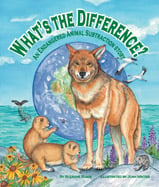Alignment to Standards for WA

| Grade | Number | Standard |
|---|---|---|
| 1 | SS-1.3.2 | Understands human interaction with the environment |
| 2 | SS-2.3.2 | Understands human interaction with the environment |
| 2 | SS-2.3.2.1a. | Explains how people affect their environment by clearing land or developing farm land to meet their need for homes and businesses. |
| 2,3 | 2-3 LS2B | All ecosystems change over time as a result of natural causes (e.g., storms, floods, volcanic eruptions, fire). Some of these changes are beneficial for the plants and animals, some are harmful, and some have no effect. |
| 2,3 | 2-3 LS2D | Humans impact ecosystems in both positive and negative ways. Humans can help improve the health of ecosystems so that they provide habitats for plants and animals and resources for humans over the long term. |
| 2,3 | 2-3 SYSB | A whole object, plant, or animal may not continue to function the same way if some of its parts are missing. |
| 3 | SS-3.3.2 | Understands human interaction with the environment |
| 4,5 | 4-5 LS1A | Plants and animals can be sorted according to their structures and behaviors. |
| 4,5 | 4-5 LS2C | Plants and animals are related in food webs with producers (plants that make their own food), consumers (animals that eat producers and/or other animals), and decomposers (primarily bacteria and fungi) that break down wastes and dead organisms, and return |
| 4,5 | 4-5 LS2D | Ecosystems can change slowly or rapidly. Big changes over a short period of time can have a major impact on the ecosystem and the populations of plants and animals living there. |
| 4,5 | 4-5 LS2E | All plants and animals change the ecosystem where they live. If this change reduces another organismês access to resources, that organism may move to another location or die. |
| 4,5 | 4-5 LS2F | People affect ecosystems both positively and negatively. |
| K,1 | K-1 LS1E | Animals have various ways of obtaining food and water. Nearly all animals drink water or eat foods that contain water. |
| K,1 | K-1 LS2C | Humans can change natural habitats in ways that can be helpful or harmful for the plants and animals that live there. |
| K,1 | K-1 LS3B | There are many different types of living things on Earth. Many of them are classified as plants or animals. |
| K,1 | K-1 LS3C. | External features of animals and plants are used to classify them into groups. |
| K,1 | K-1 LS3C.1 | Describe several external features and behaviors of animals that can be used to classify them (e.g., size, color, shape of body parts). |
| K,1 | K-1 LS3C.3 | how pairs (males/females) of plants and/or animals are similar to and different from each other (e.g., cats and dogs both have four legs, but many dogs have longer snouts than cats). |